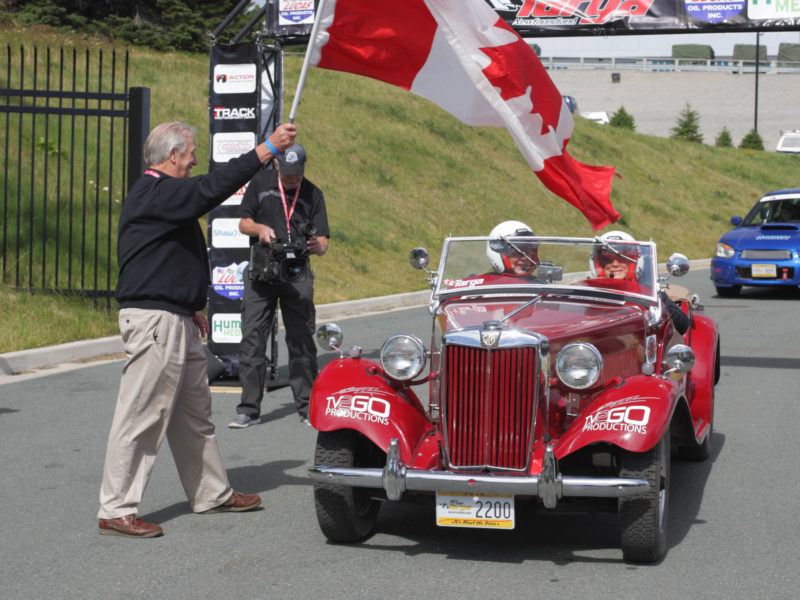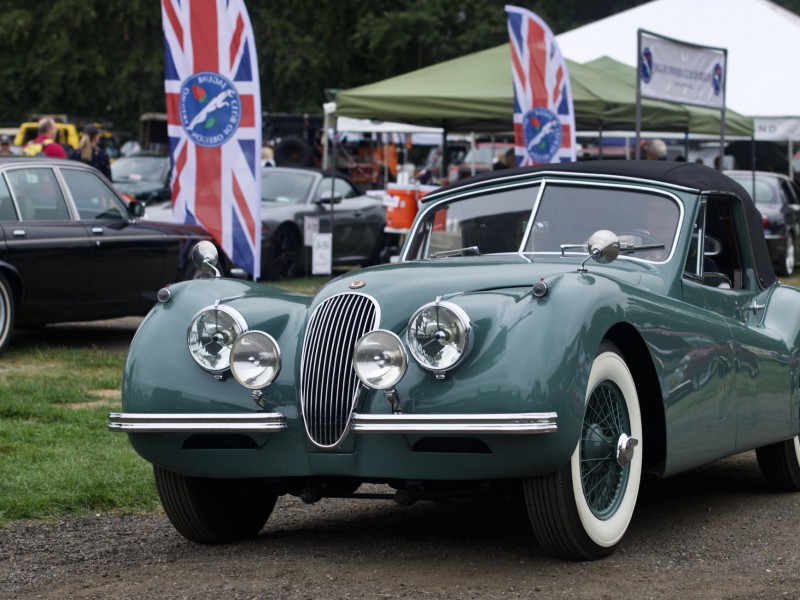The thought of hurling across the salt lakes of Utah at 200 mph is terrifying to most. There was a time when land speed record holders were kings and those speeds were not for people with weak bladders. Heroes like these were living out the dreams of little boys who plowed their toy cars through sandpits in every backyard across this land.
Father and son team Steve and David Pike of Marsh Classic Restorations of Bacchus Marsh are turning back the clock and are now attempting it all over again. The Victorians have replicated a 100S sports prototype Austin Healey ‘Endurance’ record breaker for a European customer and then set their sights on an even faster land speed record car called the Streamliner. Together the Pike’s have built a rocket that would be described in our high tech era as rudimentary, but the boys have remained faithful to Austin Healey’s original designs.
In 1954 Donald Healey hoped to sell his cars to cashed up Americans who enjoyed the English sports variants, and what better way to promote them other than by breaking speed records. The Bonneville Salt Flats of Utah in 1954 had a 14-mile straight and a now defunct 10-mile circuit track.
Healey constructed two vehicles. Each was based on the 100S competition models. The first was a prototype ‘Endurance’ car which was driven by Donald Healey, George Eyston and Carroll Shelby amongst others. They achieved average speeds over 24 hours of 132.29 mph and 142.63 mph. The second car was the Streamliner. Donald Healey achieved 192.6 mph. He was hoping to crack 200 mph.
Steve Pike said, “We took both replica cars to the US to go after both records. At the Bonneville Salt Flats, Healey wanted the Streamliner to be called the 200 but it didn’t quite get there. We hope to reach it and then we’ll be happy.”
Pike left his job as an accountant in the early 80s and ever since he has been restoring Healey’s of all models since. “I’ve always been involved with the 100S racing cars. My first car was a 100BNR, then a 100-6, and then a 100S. I had one with a Roll’s engine that was one of only three prototype cars. Even before I started this business I’ve owned, restored or made parts for the 100S model. I originally went to America and brought back three cars to restore for customers. Therefore it was right down my ally to build the speed car. This place has been my workshop as well as my hobby.”
Pike’s team studied the original Streamliner drawings and scrutinized old publicity photos. Everything was to be just as the engineers from the Longbridge factory had wanted it. The Pikes even gained the assistance of Gerry Coker who was an engineer on Healey’s original project.
“I never thought I’d be building these cars. A customer had found parts that weren’t from a road going car including a David Brown 100S gearbox housing. They were from the 100S prototype SPL227 Endurance car. I guess it started from there.”
To the rear of the workshop David is working on the jig where a brand new 100S chassis takes shape. The Streamliner also started life here. The boys had spent countless hours piecing together how to construct the car to specification. “The original had a seamed chassis with strengthening gussets and alloy subframes, so we’ve been faithful to the original.”
“We had some new drawings made up with the help of a European Engineer and Gerry who is still living in America. He was a designer of the original cars. We didn’t make a buck for this but had the body formed using close to traditional coach building techniques. “Master coach builder Paul Jenkins came out from England and taught David coach building techniques. David is a panel beater by trade and he did the body work of the Streamliner in eight weeks.”
When construction was well underway the Victorians conceded that original mechanicals wouldn’t’ be simple to replicate or find. “The original car had a DBR1 gearbox which isn’t found easily these days. We’re using a five speed Rover box which is quite generic. The clutch had cooked itself on a run so it’s something we need to address.”
The radiator was sourced from an Armstrong Siddley. “The owner also had two brand new steering wheels which were quite a match to the original. It was perfect timing. The dash looks much like the original despite the modern safety equipment in there. The boost gauge comes from a Spitfire.”
The Dunlop racing wheels were obtained for a princely sum. “They’re originally from a D-type Jaguar. The tires have had their tread buffed so that they don’t overheat at 60psi which can happen on the salt flats.”
“The mechanical package has proved to be the biggest challenge” Steve explains. “We’ve found the car to present drive problems at the most inconvenient times. You can’t test these except on the salt flats, so you hope for the best at the start run through.”
“We went to Bonneville (Utah Salt Flats Racing Association’s “World of Speed” event) in September 2009. The 2,660cc Healeys were classified for the International and National “D” category for vehicles up to 3 litres.”
Steve fired up the four cylinders. It spurted to life in an instant. Incredibly loud and eager to rev much, much more, I was surprised when Steve explained about the troubles in Utah. “We could barely start it. We subsequently used a 30 degree advance on the distributer. Now it runs like this,” he smiled.
The smiles weren’t necessarily out there on the salt flat though. Steve first attempt at a run ended quickly because of a supercharger drive failure. For his second attempt, Steve never got going because of an incident at the start line where damage was caused to the parachute/push bumper connection. Time was running out, the parachute had been prematurely deployed and they couldn’t run without it.
In-between Steve’s run, his son David had a turn. “He had to do 150mph on the first pass so he could qualify to do a 175mph run through. He clocked 150.5mph.”
“We needed to find more power and improve the bottom end. These are the liability of the car. Healey used a Shorrock Supercharger but we couldn’t find one. At Bonneville we used a Wade but it was under-engineered and difficult to keep the drive connected. When we came home we asked Bob Fisher a supercharger specialist in Melton to build us a 471 GM. They’re common in drag racing. We touched it up to make it look period.”
In March 2010 at Lake Gairdner in South Australia things were looking much more promising. Steve started out at obtaining his lower speed licenses. He had an early sense of excitement that the magical 200 mph mark was not too far away.
“I had to start at the lowest speed, the 125 mph run through. I did 127 mph and then a second pass at 150 mph. For that I thought I’d see what fourth gear at 5500 revs will do. I did 180 mph, so I got a little smack on the hand,” Steve smiles.
Perhaps David had salt fever for his 175 mph pass. He clocked 189 mph on Pike’s GPS and the officials recorded 195 mph, however the crank shaft broke. “David was qualified to do a 150 mph pass already so he was ready to do his 175 mph run. It was our chance to finally test the parachute at that speed. It was to be his next licensing step before the 200. He got a little smack on the hand as well.”
Another breakdown and an ever so close milestone achievement had eluded the boys one more time. “The 200 is what we wanted to achieve. We’d be happy then. Donald Healey couldn’t do it in 1954.”
The car returned to Bacchus in March and the engine was pulled out to be extensively rebuilt. “We had the power and the gearing right, just the reliability was missing.”
After the Utah expedition Healey returned the Speedcar to England. It was a featured of the London Motor Show at Earls Court in ’54. The car then appeared at Silverston in ’55 where it completed a lap of the circuit. “The car had suffered from too much exposure from the salt. In 1960 there was no longer any use for it. Everything was scrapped; however, the engine was placed in a production car which is currently here in Australia.”
Steve’s replica was displayed at the Australian Grand Prix in 2010 and it attracted a lot of attention. It was then demonstrated at the historic carnivals at Winton and Phillip Island. “You get a bit of interest with projects like these. Even before they were complete we had the pleasure of John Healey visiting us.”
Pike is now set on getting the speed car ready for another assault at Bonneville in September this year. “The car has been tested on the dyno extensively as the next run is the 200mph attempt. Donald Healey also tried three times. We have learned a great deal and will be better prepared this time.” I hope for Steve’s sake that history won’t be repeated.







'Austin-Healey 100S Streamliner Replica' has 1 comment
December 23, 2012 @ 9:26 pm Chris Conrad
Team Healey was out trying again this last year at Bonneville. For all of the enthusiasm and the incredible work on the streamliner, they eventually had to pull the plug on the competition course and ran the 150 mph club track. Steve clicked off a 158.416 on a course shorter than the streamliner was designed for, which is impressive in that the course was less than 1/2 the length necessary to get the Healey up to top speed. Still, after two trips to the states from Australia, they earned all the seat time they could get.
I was there in 2009, and I can attest to the beauty of this car, and the team’s frustration when the intake plumbing went afoul.
The last two years at Lake Gairdner have been rained out. I don’t know it they intend to compete in Australia in 2013, but I have friends and sources on the salt down under, and I’ll post up if they do.